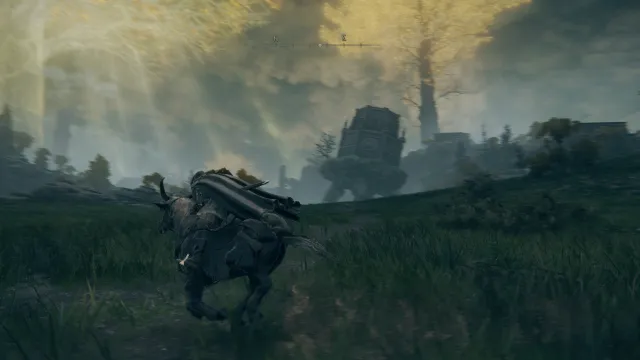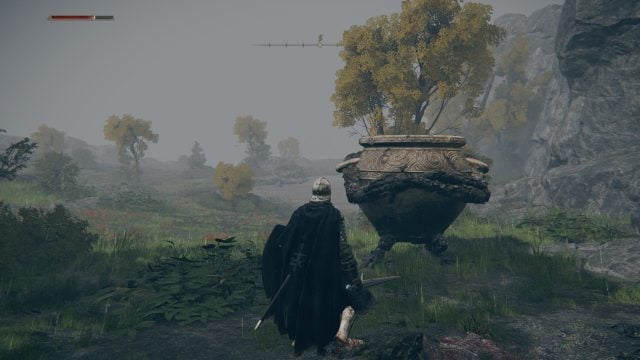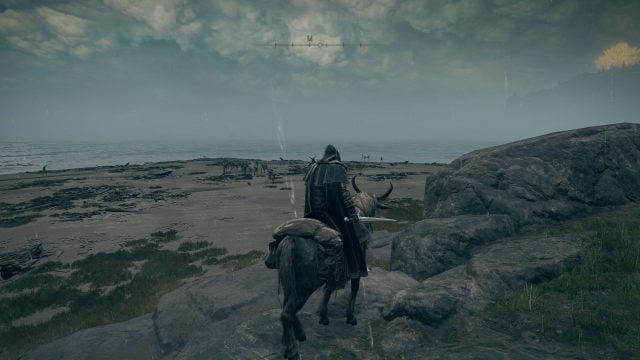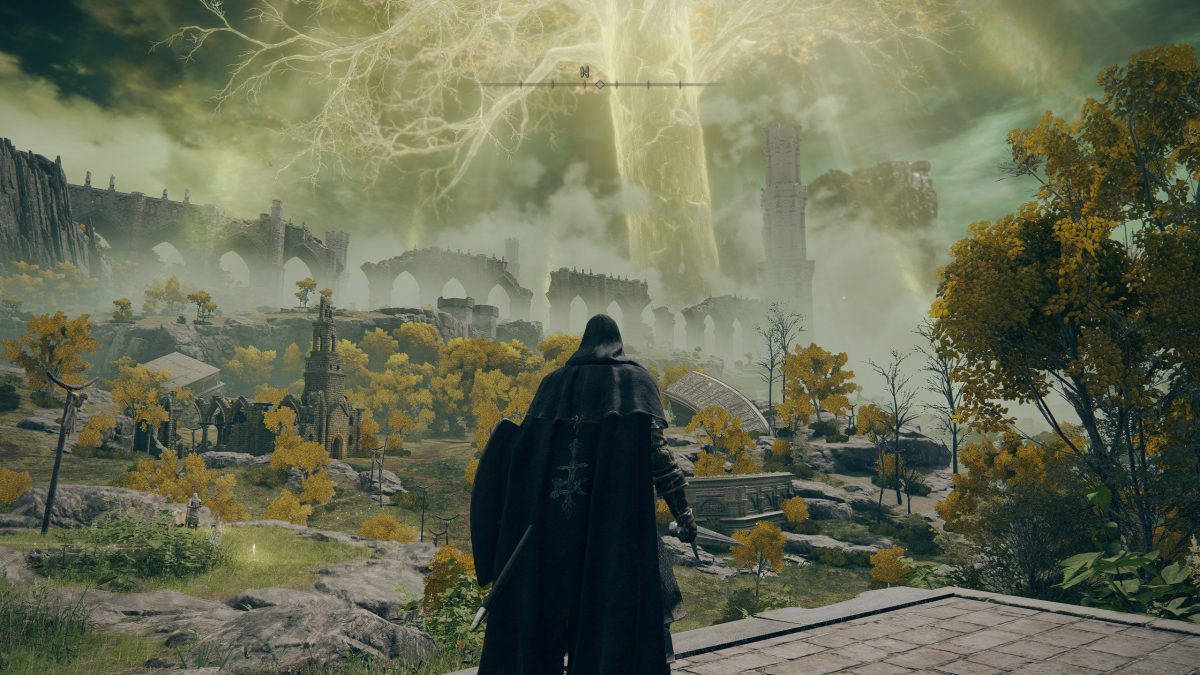Elden King
It’s time for another From Software game! Gather around as we talk about Elden Ring, which needs no introduction.
I’ll get this out of the way: Elden Ring is possibly my favorite From Software game yet. I’m going to have to simmer on this (I’m on my second playthrough now) for years to come, but it’s looking really good based on a full completion and change. Let’s dig into this monstrous adventure.

Elden Ring (PC, PS4, PS5 [reviewed], Xbox One, Xbox Series X/S]
Developer: From Software
Publisher: Bandai Namco
Released: February 25, 2022
MSRP: $59.99
One of the biggest selling points of Elden Ring is that it has an actually engaging open world. So many open games have become bloated messes, mere parodies of the genre, in recent years. Pins upon pins upon pins, with tie-ins and companion apps; it’s ridiculous in some cases. But Elden Ring feels fully complete, in the sense that discovery is paramount before reaching marked destinations for small dopamine hits. I constantly found myself looking off in the distance, and becoming fixed with finding out how to get somewhere. The EldenSekiSoulsBorne (coined!) spirit is alive and well.
Dead bodies in ornate chairs and the hubris of royalty is still a mood: and a unique one in the landscape of games. While the story is still very low key at times, I enjoyed the effort to pack in more lore via textual ruins, as it’s way easier to piece things together that are actually in the game, and not in an interview or wiki. I honestly couldn’t tell you which parts feel like they were touched by George R. R. Martin, but having read through all of the Game of Thrones book series, that’s fine with me. Miyazaki and company have been doing just fine on their own so far, and Elden Ring continues that trend.
It’s also true to form in other ways. Small caves leading to big areas is a big part of Elden Ring‘s DNA: caves you may miss entirely on your first playthrough. But there are also super obvious landmarks to visit in an organic way by simply coming across them. As you start to weave together routes, locations of secret merchants, and far away points of interest, the game really comes alive. Running into a convoy of enemies and figuring out how (or where) to approach them is a unique thrill that’s inherent to From Software games, but feels bigger in scope because of the fabric in which Elden Ring is comprised.
The series has undergone some changes, mostly for the better, in the quality-of-life department. At one point I had wandered around the map for a while without checking the navigation screen, stumbled into a tomb, got ambushed, and died. When I was prompted to resurrect, I had the option to head to a checkpoint called a Stake of Marika (presumably near that tomb), or the last site of grace [bonfire]. I chose the former, found myself very close to my body, and got my runes [souls in other games; currency you use to level up or buy things] back I had lost. Some may call parts of Elden Ring “easier” on paper, but I just see it as convenient.
It doesn’t feel easier, at least. The “marking where you need to go” bread crumb mechanic, which was announced around when the game was revealed, isn’t even that descriptive. While NPCs do give you vague hints of what area to go to and glowing arrows point to places of interest, not all of them are going to be story/critical path locations. On one occasion, I spent a few hours trekking through an area with a marker that turned out to be completely optional.
Because the game is so big, and things can feel so aimless, adding a convenient mount on top of the other quality-of-life features is a genius move, because Elden Ring wouldn’t work nearly as well if it was more rigid. Instant fast travel is a Godsend, especially for quests that ask you to immediately about-face and head back down the same path you just ran through. Testing it out on a PS5 made this process even smoother, as loads were near-instant. The technical and design advancements actively encourage more exploration without the contrivances. The Stakes of Marika, which function as little “checkpoint” fires for (many, but not all) boss fights make repeat attempts more fun/quicker too.
Galloping around on a horse and jumping are two small things that I take for granted in a lot of other games, but here, they’re even more appreciated. It’s really addicting, meandering about the map, and trying to jump up to get a better view of everything. Again, it’s all organic. When exploring, I would often use higher ground to find a legitimately cool-looking or interesting area, mark it on the map, then go to it. It’s not too gamey or cynical. No joke, I spent hours roaming around in between “story bosses.” And you know what? It even has a low key marker/stamp system to draw in your own personal map: and I didn’t even find the option to trigger stamps until my second playthrough (just the light-ray objective markers, which are limited).
The map is far bigger than expected, going beyond the limits of what the screen shows you at first. You’re constantly coming across new stuff, because exploration is so expansive. So there are some gates (think keys you need to get into specific areas), but by and large you can explore nearly the entire map. Finishing a “story” boss will lead you to the next area by default, or you can sometimes sneak there using a hidden path and sequence break (to a point). If you’re worried about a lack of “traditional” areas: don’t be. There are plenty of massive, deliberate zones just like the old games. That said, some of the open world stuff isn’t as exciting as I’d like.

Micro-dungeons can get derivative, much like the Chalice layouts in Bloodborne. There’s tiers of said dungeons, from “ruins” (which are glorified treasure chests), to dungeons (think chalice), to caves (usually with weapon-enhancing materials), and so on. Some of them are a cut above and more clever with unique layouts and puzzles, but those are typically found near the end of the game. There is, however, a very cool take on subterranean map design (that I won’t spoil here) that makes up for it.
When I was at the foot of the final boss, I went back and found 15 hours of more stuff to do, and didn’t exhaust it all. The “40-hours-or-more” mark for a first playthrough is roughly what a lot of people are looking at, erring on the side of “more.” In fact, on my second playthrough, I found at least 10 things I hadn’t done before in the first five hours of that next go-around. The scope should encourage multiple playthroughs more than any past From Software title.
And yet, the open world changes nothing in terms of the heart and soul of Elden Ring. A miniboss can still pop out and wreck you harder than the required boss you’re on your way to fight. NPCs can die due to unforeseen story machinations. Some of you are probably thinking “that’s stupid that this is still around.” The Souls fans out there are rubbing their hands together in excitement.
We do this discourse every time From Software releases something. It’s occasionally frustrating, but always exciting and unpredictable for a large group of people: myself included. I’m still thinking about a few of the game’s puzzles, and even took physical notes this time because of how much there was to track.
Combat gets a lift from a more open loadout system. Mixing and matching playstyles and weapon types is super easy, and making your own potion to suit your needs (using a combination of two effects, which you’ll pick up throughout the game by killing tree guardians) is peak Elden Ring customization. From a mechanical perspective, most of the weapon types feel precise, and on a PS5, I had no real technical complaints. There are too many individual facets to talk about, but the amount of freedom I felt was overwhelming at times. Instead of just pumping stats into a character like so many other lite RPGs, I put some actual thought into how I wanted to approach everything. That includes weapon modification, what abilities to imbue, and what armor pieces to wear.

Summoning NPCs as a magic spell (instead of through some laborious one-off sigil you might need to wait for or never find) is an insane upgrade for solo players both now and forever, as long as the game exists and servers become less populated. Crafting, while rote in many games, feels natural here, because the items you can craft actually matter to some builds, or you can ignore it entirely.
A fully-fledged multiplayer component, which has everything from PVP to PVE in one place, could ensure that Elden Ring‘s legacy will live on as long as most of the other Souls games have. Again, it’s a long time coming, but it came all the same.
So many challenges are optional that it not only funnels into that aforementioned genuine sense of discovery, but it also feels like you can choose how difficult you want the game to be. Sure, there are roadblocks in the sense that critical path encounters lead to new areas, potentially new items/upgrades, and better places to farm/level-up. Some of those gates are going to be annoying if you want a constant sense of story progression. I even felt the pang of linearity near the end of the game as things were wrapping up and funneling into a pointed series of boss fights.
Given how much Elden Ring encourages you to sit back and enjoy it, it was never truly an issue for me, because I could take a break and go explore somewhere else. It also doesn’t sacrifice the core Souls loop of overcoming challenges and the sense of accomplishment that hits you like a ton of bricks afterward. Yes, that setup isn’t for everyone. But I also think that Elden Ring is one of the most accessible From offerings yet from a skill floor perspective, while catering to everyone who has been along for the ride this whole time (the ceiling can get high still).

To say I was blown away by Elden Ring is an understatement. Sure it’s still going to appear esoteric and unapproachable to a subset of people. There are things it could still do better in terms of onboarding, and it could do even more on the front of quality-of-life enhancements for returning Souls players.
But as an experience, it’s one of the most wondrous and open-ended games I’ve played in years. It has so much to say from a design perspective that people will be talking about its choices for years on end, and playing it for longer.
[This review is based on a retail build of the game provided by the publisher.]





Published: Feb 23, 2022 09:00 am